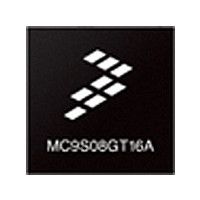MC9S08GT16CFB Freescale Semiconductor, MC9S08GT16CFB Datasheet - Page 192

MC9S08GT16CFB
Manufacturer Part Number
MC9S08GT16CFB
Description
Manufacturer
Freescale Semiconductor
Datasheet
1.MC9S08GT16CFB.pdf
(290 pages)
Specifications of MC9S08GT16CFB
Cpu Family
HCS08
Device Core Size
8b
Frequency (max)
20MHz
Interface Type
SCI/SPI
Program Memory Type
Flash
Program Memory Size
16KB
Total Internal Ram Size
1KB
# I/os (max)
36
Number Of Timers - General Purpose
4
Operating Supply Voltage (typ)
2.5/3.3V
Operating Supply Voltage (max)
3.6V
Operating Supply Voltage (min)
2.08V
On-chip Adc
8-chx10-bit
Instruction Set Architecture
CISC
Operating Temp Range
-40C to 85C
Operating Temperature Classification
Industrial
Mounting
Surface Mount
Pin Count
44
Package Type
PQFP
Lead Free Status / Rohs Status
Not Compliant
Available stocks
Company
Part Number
Manufacturer
Quantity
Price
Company:
Part Number:
MC9S08GT16CFBE
Manufacturer:
FREESCALE
Quantity:
1 831
Company:
Part Number:
MC9S08GT16CFBE
Manufacturer:
Freescale Semiconductor
Quantity:
10 000
Part Number:
MC9S08GT16CFBE
Manufacturer:
FREESCALE
Quantity:
20 000
Company:
Part Number:
MC9S08GT16CFBER
Manufacturer:
Freescale Semiconductor
Quantity:
10 000
- Current page: 192 of 290
- Download datasheet (2Mb)
Serial Peripheral Interface (SPI) Module
12.2.3
As shown in
prescale bits (SPPR2:SPPR1:SPPR0) choose a prescale divisor of 1, 2, 3, 4, 5, 6, 7, or 8. The three rate
select bits (SPR2:SPR1:SPR0) divide the output of the prescaler stage by 2, 4, 8, 16, 32, 64, 128, or 256
to get the internal SPI master mode bit-rate clock.
12.3
An SPI transfer is initiated by checking for the SPI transmit buffer empty flag (SPTEF = 1) and then
writing a byte of data to the SPI data register (SPI1D) in the master SPI device. When the SPI shift register
is available, this byte of data is moved from the transmit data buffer to the shifter, SPTEF is set to indicate
there is room in the buffer to queue another transmit character if desired, and the SPI serial transfer starts.
During the SPI transfer, data is sampled (read) on the MISO1 pin at one SPSCK edge and shifted, changing
the bit value on the MOSI1 pin, one-half SPSCK cycle later. After eight SPSCK cycles, the data that was
in the shift register of the master has been shifted out the MOSI1 pin to the slave while eight bits of data
were shifted in the MISO1 pin into the master’s shift register. At the end of this transfer, the received data
byte is moved from the shifter into the receive data buffer and SPRF is set to indicate the data can be read
by reading SPI1D. If another byte of data is waiting in the transmit buffer at the end of a transfer, it is
moved into the shifter, SPTEF is set, and a new transfer is started.
Normally, SPI data is transferred most significant bit (MSB) first. If the least significant bit first enable
(LSBFE) bit is set, SPI data is shifted LSB first.
When the SPI is configured as a slave, its SS1 pin must be driven low before a transfer starts and SS1 must
stay low throughout the transfer. If a clock format where CPHA = 0 is selected, SS1 must be driven to a
logic 1 between successive transfers. If CPHA = 1, SS1 may remain low between successive transfers. See
Section 12.3.1, “SPI Clock
Because the transmitter and receiver are double buffered, a second byte, in addition to the byte currently
being shifted out, can be queued into the transmit data buffer, and a previously received character can be
in the receive data buffer while a new character is being shifted in. The SPTEF flag indicates when the
transmit buffer has room for a new character. The SPRF flag indicates when a received character is
available in the receive data buffer. The received character must be read out of the receive buffer (read
SPI1D) before the next transfer is finished or a receive overrun error results.
In the case of a receive overrun, the new data is lost because the receive buffer still held the previous
character and was not ready to accept the new data. There is no indication for such an overrun condition
so the application system designer must ensure that previous data has been read from the receive buffer
before a new transfer is initiated.
192
Functional Description
SPI Baud Rate Generation
Figure
BUS CLOCK
12-4, the clock source for the SPI baud rate generator is the bus clock. The three
Formats,”
SPPR2:SPPR1:SPPR0
1, 2, 3, 4, 5, 6, 7, or 8
Figure 12-4. SPI Baud Rate Generation
PRESCALER
DIVIDE BY
MC9S08GB/GT Data Sheet, Rev. 2.3
for more details.
2, 4, 8, 16, 32, 64, 128, or 256
CLOCK RATE DIVIDER
SPR2:SPR1:SPR0
DIVIDE BY
MASTER
SPI
BIT RATE
Freescale Semiconductor
Related parts for MC9S08GT16CFB
Image
Part Number
Description
Manufacturer
Datasheet
Request
R
Part Number:
Description:
Manufacturer:
Freescale Semiconductor, Inc
Datasheet:
Part Number:
Description:
Manufacturer:
Freescale Semiconductor, Inc
Datasheet:
Part Number:
Description:
Manufacturer:
Freescale Semiconductor, Inc
Datasheet:
Part Number:
Description:
Manufacturer:
Freescale Semiconductor, Inc
Datasheet:
Part Number:
Description:
Manufacturer:
Freescale Semiconductor, Inc
Datasheet:
Part Number:
Description:
Manufacturer:
Freescale Semiconductor, Inc
Datasheet:
Part Number:
Description:
Manufacturer:
Freescale Semiconductor, Inc
Datasheet:
Part Number:
Description:
Manufacturer:
Freescale Semiconductor, Inc
Datasheet:
Part Number:
Description:
Manufacturer:
Freescale Semiconductor, Inc
Datasheet:
Part Number:
Description:
Manufacturer:
Freescale Semiconductor, Inc
Datasheet:
Part Number:
Description:
Manufacturer:
Freescale Semiconductor, Inc
Datasheet:
Part Number:
Description:
Manufacturer:
Freescale Semiconductor, Inc
Datasheet:
Part Number:
Description:
Manufacturer:
Freescale Semiconductor, Inc
Datasheet:
Part Number:
Description:
Manufacturer:
Freescale Semiconductor, Inc
Datasheet:
Part Number:
Description:
Manufacturer:
Freescale Semiconductor, Inc
Datasheet:











